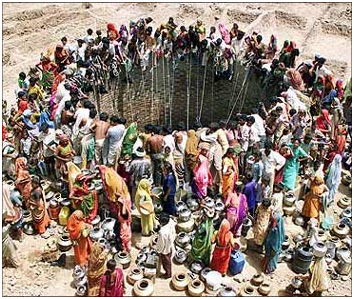Water, Water Everywhere, But Not Many Drops to Drink
Potable drinking water: a huge scarcity

BANGALORE: March 22 is World Water Day 2015 and it goes without saying really, that without water there can be no life. Clean water in today's world means health, income and education,
With research done by scientists, one is aware that diseases from unsafe water and lack of basic sanitation kill more people every year than all forms of violence, including war. Children are especially vulnerable, as their bodies aren't strong enough to fight diarrhea, dysentery and other illnesses.
As per information on the net, 90% of the 30,000 deaths that occur every week from unsafe water and unhygienic living conditions are in children under five years old. The WHO reports that over 3.6% of the global disease burden can be prevented simply by improving water supply, sanitation, and hygiene.
" Water is at the core of sustainable development and is critical for socio-economic development, healthy ecosystems and for human survival itself. It is vital for reducing the global burden of disease and improving the health, welfare and productivity of populations. It is central to the production and preservation of a host of benefits and services for people. Water is also at the heart of adaptation to climate change, serving as the crucial link between the climate system, human society and the environment," says Joakim Harlin a water resources and international development professional from UNDP.
He goes on to say, "Water is a finite and irreplaceable resource that is fundamental to human well-being. It is only renewable if well managed. Today, more than 1.7 billion people live in river basins where depletion through use exceeds natural recharge, a trend that will see two-thirds of the world’s population living in water-stressed countries by 2025. Water can pose a serious challenge to sustainable development but managed efficiently and equitably, water can play a key enabling role in strengthening the resilience of social, economic and environmental systems in the light of rapid and unpredictable changes."
The Millennium Development Goals (MDGs), agreed in 2000, aim to halve the proportion of people without sustainable access to safe drinking water and basic sanitation between 1990 and 2015. But today in 2015, a total of 748 million people still do not have access to an improved drinking water source and existing indicators do not address the safety and reliability of water supplies. To reach the requirements of the right to access to safe drinking water requires real improvements for several billions of people.
In July 2010, the UN General Assembly adopted a resolution, which “recognized the right to safe and clean drinking water and sanitation as a human right that is essential for the full enjoyment of life and all human rights.”
The MDG target for sanitation is an even more pressing challenge, with 2.5 billion people currently lacking access to improved sanitation and over one billion still practicing open defecation. At current rates of progress, the sanitation target will be missed by over half a billion people. These global aggregates also mask large disparities between nations and regions, rich and poor, between rural and urban populations, as well as between disadvantaged groups and the general population.
There is currently no global target to improve hygiene, despite this being one of the single most cost-effective public health interventions.
Of all of the targets in the proposed Sustainable Development Goals (SDG), the one on Water is highly relevant for India. The first two targets are related to drinking water and sanitation, target three is about water quality, target four deals with water-use efficiency to ensure sustainable withdrawals and supply, target five addresses water governance, and target six the protection of water-related ecosystems.
Even if India has made good progress in providing drinking water to its people during the MDG period the Joint Monitoring Programme (WHO/UNICEF) estimates that 97 million people still are without access to improved sources of drinking water, with gross disparity in coverage across the country. Pollution of drinking water is also a huge problem which is directly related to the large number of people (626 million) who practice open defecation. As a result, the World Bank estimates that roughly 21% of communicable diseases in India are related to unsafe water. In India, diarrhea alone causes more than 1,600 deaths daily.
In India the competition for this precious resource is growing rapidly as the economy and population grows. Satellite data reveals that there has been a decline in the ground water level of 4 centimeters each year between 2002 and 2008 in the alluvial tracks of Northern India where natural rates of recharge are high. This is equivalent to an increase in over 70 per cent in the rate of water extraction compared to the previous decade. If we consider that irrigation accounts for 80 per cent of India’s water usage, and 60 per cent of irrigation water and 80 per cent of rural drinking water come from groundwater one can imagine the extent of the socio-economic impacts of the groundwater crisis alone.
India’s ability to sustain its rapidly expanding population and to develop in a sustainable manner will depend on how it addresses all the targets of the proposed Sustainable Development Goals on Water. Building capacity from local to central level, mobilizing finance, investing in infrastructure and improving the governance of water, in a manner that ensures its sustainable and equitable use, are key action areas for achieving the targets of the water goal says the UN.



